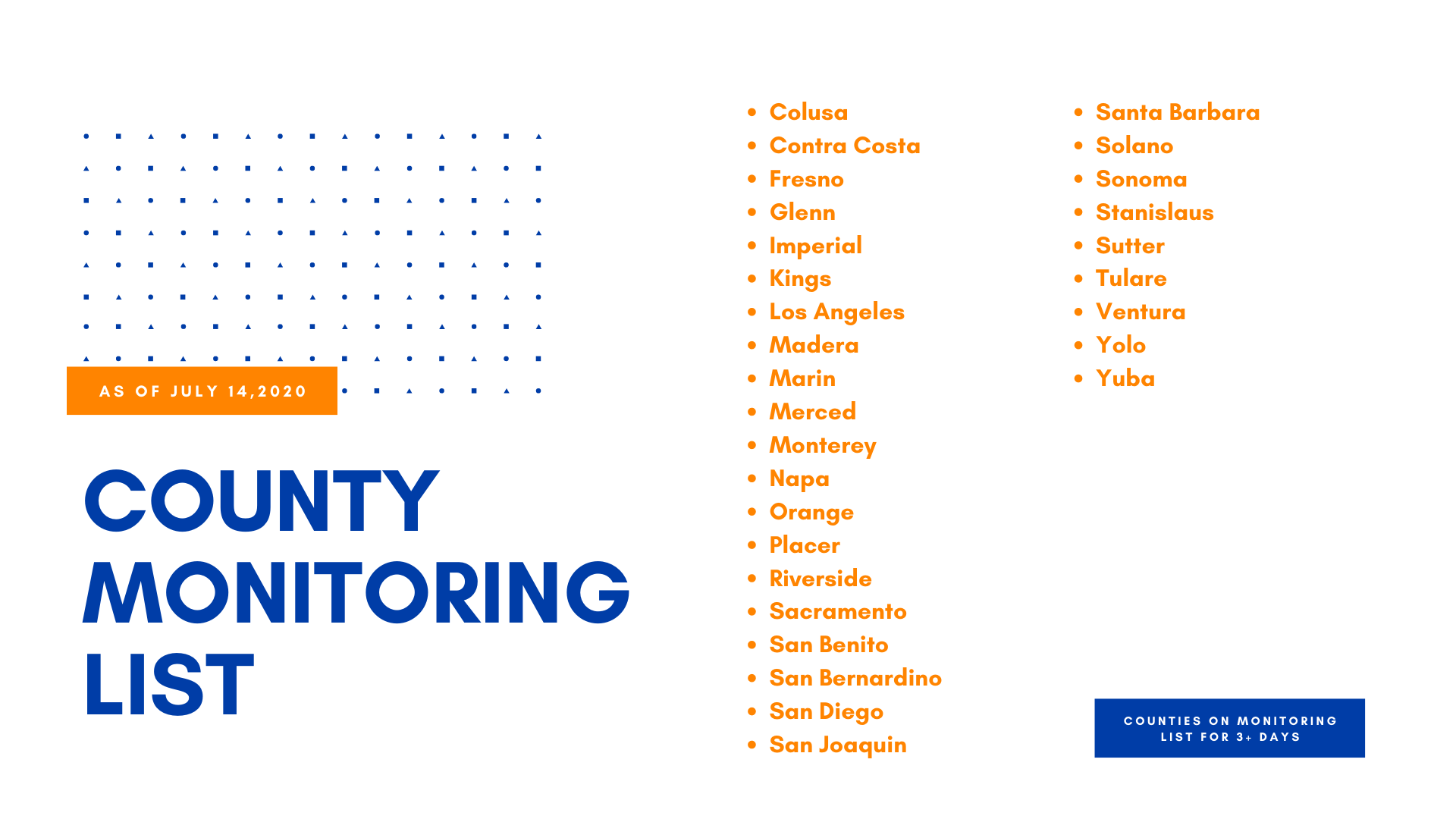State Officials Announce Latest COVID-19 Facts
SACRAMENTO – The California Department of Public Health today announced the most recent statistics on COVID-19.
- California's positivity rate – a key indicator of community spread – is trending upward in the 14-day average.
- Hospitalization rates are also trending upward in the 14-day average.
- Numbers may not represent true day-over-day change as reporting of test results can be delayed, and the 7-day average more accurately describes trends in number of cases. The 7-day average number of new cases is 8,382 per day. The 7-day average from the week prior was 7,837. California has 336,508 confirmed cases to date.
- There have been 5,674,955 tests conducted in California. This represents an increase of 130,590 over the prior 24-hour reporting period. As testing capacity continues to increase across the state, an increase in the number of positive cases has been expected – increasing the importance of positivity rates to find signs of community spread.
- There have been 7,087 COVID-19 deaths since the start of the pandemic.
- A total of 29 counties are required to close indoor operations for certain sectors based on the July 13 order to slow
community transmission.


Testing in California
As testing capacity continues to increase across the state, the California Department of Public Health is working to expand access to COVID-19 testing. Testing should be used for medical evaluation of persons with symptoms of COVID-19 as well as for efforts by public health agencies and essential employers to prevent and control the spread of COVID-19. Individuals prioritized for testing include:
- Hospitalized patients
- Symptomatic and asymptomatic healthcare workers, first responders, and other social service employees
- Symptomatic individuals age 65 and older or symptomatic individuals of any age with chronic medical conditions that increase the risk of severe COVID-19 illness
- Individuals who are tested as part of disease control efforts in high-risk settings
- Asymptomatic residents and employees of congregate living facilities when needed to prevent disease transmission
- Symptomatic and asymptomatic individuals in essential occupations such as grocery store and food supply workers, utility workers and public employees
- Other individuals with symptoms consistent with COVID-19
Data and Tools
A
wide range of data and analysis guides California’s response to COVID-19. The
state is making the data and its analytical tools available to researchers,
scientists and the public at covid19.ca.gov.
Popular links include:
Racial Demographics – A More Complete Picture
The
California Department of Public Health is committed to health equity and
collecting more detailed racial and ethnic data that will provide additional
understanding for determining future action. Health outcomes are affected by
forces including structural racism, poverty and the disproportionate prevalence
of underlying conditions such as asthma and heart disease among Latinos and
African American Californians. Only by looking at the full picture can we
understand how to ensure the best outcomes for all Californians.
The differences in health outcomes related to COVID-19 are most stark in
COVID-19 deaths. We have nearly complete data on race and ethnicity for
COVID-19 deaths, and we are seeing the following trends: Latinos, African
Americans, Native Hawaiians and Pacific Islanders are dying at
disproportionately higher levels. More males are dying from COVID-19 than
females, in line with national trends. More information is available at COVID-19 Race and Ethnicity Data.
Health Care Worker Infection Rates
As
of July 13, local health departments have reported 17,910 confirmed positive
cases in health care workers and 100 deaths statewide.
County Monitoring Data
California is using data and science to respond to COVID-19. Data by county gives Californians insight into how their county is doing and provides an early indication of developing areas of concern. Counties on the County Monitoring List for three or more consecutive days – currently 29 counties accounting for 80 percent of the state's population – must close indoor operations for additional activities. 
For more information, visit the County Data Monitoring webpage.
Your Actions Save Lives
Every person has a role to play. Protecting yourself and your family comes down to common sense:
Staying home except for essential needs/activities following local and state public health guidelines when patronizing approved businesses. To the extent that such sectors are re-opened, Californians may leave their homes to work at, patronize, or otherwise engage with those businesses, establishments or activities.
Practicing social distancing.
Wearing a cloth face mask when out in public.
Washing hands with soap and water for a minimum of 20 seconds.
Avoiding touching eyes, nose or mouth with unwashed hands.
Covering a cough or sneeze with your sleeve, or disposable tissue. Wash your hands afterward.
Avoiding close contact with people who are sick.
Staying away from work, school or other people if you become sick with respiratory symptoms like fever and cough.
Answer the call if a contact tracer from the CA COVID Team or your local health department tries to connect. Contact tracers will connect you to free, confidential testing and other resources, if needed.
Following guidance from public health officials.
What to Do if You Think You're Sick
Call
ahead: If you are experiencing symptoms of COVID-19 (fever, cough or shortness
of breath), call your health care provider before seeking medical care so that
appropriate precautions can be taken. More than 100 community testing sites
also offer free, confidential testingg: Find a COVID-19 Testing Site.
For more information about what Californians can do to prevent the spread of COVID-19, visit Coronavirus (COVID-19) in California.
California continues to issue guidance on preparing and protecting California from COVID-19. Consolidated guidance is available on the California Department of Public Health's Guidance web page.